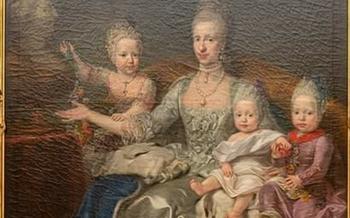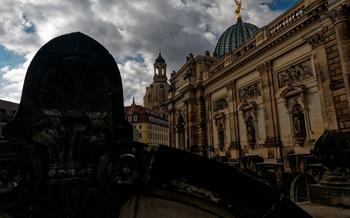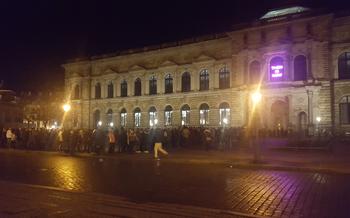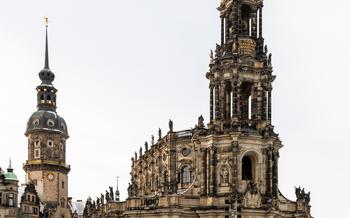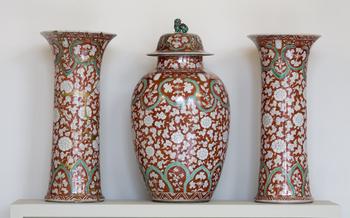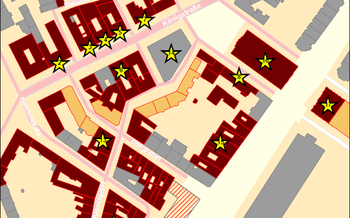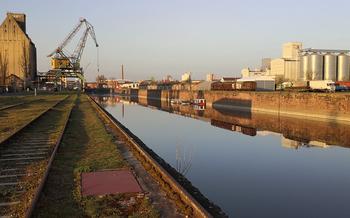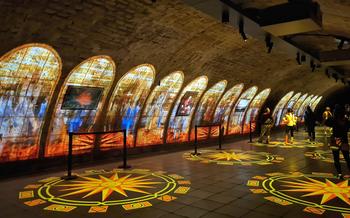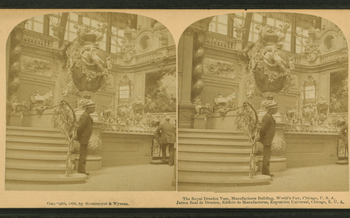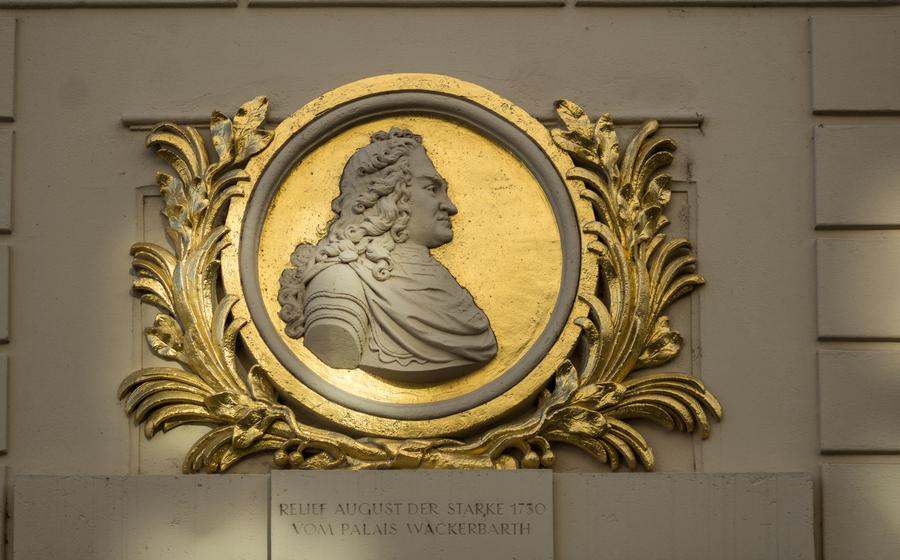
August the Strong Monument
- August the Strong Monument: A Monumental Tribute
- Exploring the Monument: A Journey Through Time
- The Dresden Zwinger: A Baroque Masterpiece
- The Royal Procession: A Spectacle of Splendor
- The Court of Augustus II: A Glimpse into the Past
- The Dresden Porcelain Collection: A Treasure Trove of Fine Art
- The Royal Library: A Haven for Knowledge and History
- The Dresden State Opera: A World-Class Performance Venue
- The Green Vault: A Treasury of Wonders
- The Church of Our Lady: A Symbol of Resilience
- The Albertinum: A Museum of Modern and Contemporary Art
- The Elbe River and the Elbe Valley: A Natural Oasis
- The Saxon Switzerland National Park: A Natural Wonderland
- Insider Tip: Exploring the City by Bike
August the Strong Monument: A Monumental Tribute
At the heart of Dresden, the magnificent August the Strong Monument stands as a testament to the legacy of one of Saxony's most illustrious rulers. Unveiled in 1736, this equestrian statue pays homage to August II, the Elector of Saxony and King of Poland, who transformed Dresden into a cultural and artistic powerhouse during his reign in the early 18th century.
The monument showcases August the Strong's grand vision for Dresden, capturing his essence as a powerful and charismatic leader. Perched atop a rearing horse, August appears majestic and commanding, embodying the strength and determination that characterized his rule. The intricate details and Baroque flourishes of the monument reflect the opulence and artistic splendor that defined his era.
Beyond its historical significance, the August the Strong Monument holds symbolic meaning for Dresden. It represents the city's resilience and its unwavering spirit in the face of adversity. Having survived the ravages of war and the passage of time, the monument stands as a beacon of hope and renewal, inspiring generations to come.
Conveniently situated in the heart of Dresden, the August the Strong Monument is easily accessible to visitors. Located on Theaterplatz, amidst other architectural marvels such as the Semperoper and the Zwinger Palace, the monument invites visitors to embark on a journey through time, exploring the rich history and vibrant culture of this remarkable city.
Exploring the Monument: A Journey Through Time
Immerse yourself in the rich history of Dresden and the legacy of August the Strong through a guided tour of the monument. Experienced guides provide insightful commentary, delving into the monument's construction, symbolism, and the life of August the Strong.
For a more intimate experience, embark on a self-guided exploration. Begin at the monument's base, admiring its intricate details and symbolism. Ascend the grand staircase, taking in the panoramic views of the city. Inside, explore the various chambers and galleries, each offering a glimpse into August the Strong's reign and the grandeur of the Saxon court.
Interactive exhibits and multimedia experiences enhance your journey through time. Touchscreens and digital displays bring the monument's history to life, allowing you to interact with historical documents, maps, and images. These interactive elements provide a deeper understanding of the monument's significance and the era it represents.
The monument is fully accessible for visitors with disabilities. Ramps, elevators, and audio guides for the visually impaired ensure that everyone can enjoy and learn from this iconic landmark.
The Dresden Zwinger: A Baroque Masterpiece
At the heart of Dresden's cultural district lies the Dresden Zwinger, a magnificent Baroque masterpiece that stands as a testament to the city's architectural grandeur. Built by Augustus the Strong in the early 18th century, this opulent complex was originally conceived as an orangery and festival ground.
The Zwinger's architectural highlights are a sight to behold. Its intricate facades are adorned with exquisite sculptures, allegorical figures, and elaborate ornamentation, showcasing the artistic prowess of the Baroque era. The central courtyard, known as the Zwingerhof, captivates with its symmetrical layout, graceful arcades, and stunning fountains.
Today, the Zwinger houses several world-renowned museums and galleries, offering a diverse range of cultural experiences. The Gemäldegalerie Alte Meister (Old Masters Picture Gallery) boasts an impressive collection of paintings from the 15th to the 18th centuries, featuring masterpieces by Raphael, Titian, and Rembrandt. The Porzellansammlung (Porcelain Collection) showcases exquisite Meissen porcelain, renowned for its delicate craftsmanship and intricate designs. The Mathematisch-Physikalischer Salon (Museum of Mathematics and Physics) offers an intriguing journey through the history of scientific instruments and discoveries.
Strolling through the Zwinger's courtyards and gardens is an experience in itself. The lush greenery, serene fountains, and meticulously manicured flowerbeds create a tranquil oasis amidst the urban hustle and bustle. The Zwinger is a place where history, art, and nature harmoniously intertwine, offering visitors an unforgettable glimpse into Dresden's rich cultural heritage.
The Royal Procession: A Spectacle of Splendor
The Royal Procession is a historical spectacle that recreates the lavish processions held by the Saxon court during the reign of Augustus II. This flamboyant display of wealth and power takes place annually in Dresden, attracting visitors from around the world.
The procession features over 800 participants dressed in elaborate historical costumes, representing various guilds, court officials, and members of the royal family. The procession winds its way through the streets of Dresden, accompanied by the sound of trumpets, drums, and other period instruments.
One of the highlights of the procession is the Kurfürst (Elector) Augustus II himself, who rides in a magnificent golden carriage drawn by eight horses. The carriage is adorned with intricate carvings and opulent decorations, befitting the grandeur of the Saxon court.
The Royal Procession is a living testament to the splendor and extravagance of the Saxon court during the 18th century. It offers a unique opportunity to step back in time and experience the opulence and grandeur of one of Europe's most powerful monarchies.
The Court of Augustus II: A Glimpse into the Past
Augustus II, also known as August the Strong, was a larger-than-life figure whose court was renowned for its opulence and extravagance. A man of immense wealth and power, he transformed Dresden into a cultural and artistic hub, attracting some of the finest minds of his time. At his court, scholars, artists, and musicians flourished, creating a vibrant and intellectually stimulating environment.
One of the most fascinating aspects of Augustus II's court was its political and cultural significance. As the Elector of Saxony and King of Poland, Augustus was a powerful figure in European politics. His court served as a meeting point for diplomats, ambassadors, and other dignitaries from across the continent. It was a place where alliances were forged, treaties were negotiated, and cultural exchanges took place.
Augustus II was also a passionate patron of the arts, and his court became a haven for artists and musicians from all over Europe. He commissioned grand works of art, including sculptures, paintings, and musical compositions, which adorned the palaces and gardens of Dresden. The court orchestra, under the direction of renowned composers such as Johann David Heinichen and Johann Sebastian Bach, was one of the finest in Europe.
Life at Augustus II's court was a whirlwind of social events, lavish banquets, and elaborate ceremonies. The court was known for its exquisite cuisine, fine wines, and extravagant costumes. Guests were entertained with music, dance, and theatrical performances, often involving hundreds of participants. The court also hosted grand hunting expeditions, which were a popular pastime among the nobility.
Augustus II's court was not without its controversies. The king's lavish spending and his pursuit of pleasure drew criticism from some quarters. However, there is no doubt that his court played a significant role in shaping the cultural and intellectual landscape of Dresden and left a lasting legacy that continues to inspire and intrigue visitors to this day.
The Dresden Porcelain Collection: A Treasure Trove of Fine Art
The Dresden Porcelain Collection, housed within the Zwinger Palace, is a testament to the exquisite craftsmanship and artistry that flourished during the reign of Augustus the Strong. Established in the early 18th century, the collection boasts over 20,000 pieces of Meissen porcelain, widely regarded as some of the finest in the world.
Meissen porcelain, renowned for its delicate translucency and intricate hand-painted designs, was first produced in 1708 at the Meissen Porcelain Manufactory, founded by Augustus the Strong. The collection showcases the manufactory's early experimental pieces, including the iconic "Böttger stoneware," named after its inventor, Johann Friedrich Böttger, to later masterpieces known for their intricate floral motifs, mythological scenes, and opulent gilding.
Among the highlights of the collection are the "Swan Service," a magnificent dinner service commissioned by Augustus the Strong, comprising over 2,000 pieces adorned with swans and intricate floral designs. The "Japanese Palace," a miniature palace made entirely of porcelain, is another masterpiece, showcasing the incredible skill and attention to detail of the Meissen artisans.
Visitors can explore the collection through guided tours, which provide insights into the history and significance of the pieces. The museum also offers interactive exhibits and multimedia experiences, allowing visitors to learn about the manufacturing process and the cultural and historical context of Meissen porcelain.
The Royal Library: A Haven for Knowledge and History
The Royal Library stands as a testament to the intellectual and cultural pursuits of the Saxon court. Its opulent Baroque architecture, designed by Matthäus Daniel Pöppelmann, houses a treasure trove of knowledge and history. The library's extensive collection boasts over 15 million books, manuscripts, and maps, spanning various subjects and languages. Among its prized possessions are the Codex Dresden, an ancient Mayan manuscript, and the Tabula Peutingeriana, a medieval map of the Roman Empire.
Visitors can embark on a journey through time as they explore the library's historic reading rooms and galleries. Guided tours offer insights into the library's fascinating history and its role in shaping Dresden's cultural landscape. Researchers and scholars can delve into the library's vast collection, accessing rare books and manuscripts through dedicated research facilities. The Royal Library stands as a testament to the enduring power of knowledge and the pursuit of intellectual enlightenment.
The Dresden State Opera: A World-Class Performance Venue
The Dresden State Opera, renowned for its world-class performances and architectural grandeur, is a must-visit destination for opera enthusiasts and culture lovers alike. With a history dating back to the 17th century, the opera house has undergone several renovations and expansions, resulting in a stunning blend of Baroque and modern architectural elements.
The auditorium, adorned with intricate chandeliers and opulent red velvet seating, creates an ambiance of grandeur and elegance. The stage, equipped with state-of-the-art technology, provides a platform for exceptional performances by renowned opera singers, ballet dancers, and musicians.
To fully experience the magic of the Dresden State Opera, consider attending a performance during your visit. The opera house offers a diverse repertoire, including classic operas, contemporary productions, and ballets. Booking tickets in advance is recommended to secure your seats and avoid disappointment.
For an unforgettable experience, splurge on a seat in the royal box, offering an exclusive perspective of the stage and the auditorium. Alternatively, opt for a guided tour of the opera house, providing insights into its history, architecture, and backstage operations.
Before or after the performance, take advantage of the opportunity to explore the historic Theaterplatz, where the opera house is situated. Admire the majestic architecture of the surrounding buildings and indulge in a delightful meal or drink at one of the charming cafés or restaurants in the area.
The Green Vault: A Treasury of Wonders
Nestled within the Dresden Castle, the Green Vault stands as a testament to the opulence and extravagance of the Saxon court. With its impenetrable walls and state-of-the-art security systems, this treasury safeguards a dazzling array of treasures that have captivated the world for centuries.
Inside its vaults, visitors are greeted by a mesmerizing display of jewelry, goldsmithing, and gemstones. The Dresden Green Diamond, a 41-carat gem of unparalleled brilliance, takes center stage, surrounded by an entourage of exquisite jewels that shimmer and sparkle under the soft glow of the chandeliers.
The treasury also boasts an awe-inspiring collection of goldsmithing masterpieces, showcasing the exceptional craftsmanship and artistry of bygone eras. Elaborate centerpieces, ornate goblets, and intricate figurines adorned with precious stones tell tales of lavish banquets and royal celebrations.
Don't miss the chance to marvel at the exquisite craftsmanship of the Dresden State Sword, a symbol of power and authority, or the opulent coronation regalia of the Saxon kings, adorned with shimmering diamonds and vibrant gemstones.
To fully appreciate the treasures of the Green Vault, guided tours are highly recommended. Knowledgeable guides will lead you through the vaults, sharing fascinating stories and anecdotes about the provenance and significance of each masterpiece. Advance booking is essential to secure your spot in this extraordinary journey through history and splendor.
The Church of Our Lady: A Symbol of Resilience
The Church of Our Lady (Frauenkirche) stands as an enduring symbol of Dresden's resilience and architectural prowess. Its history is intertwined with the city's trials and triumphs, having survived wars, fires, and countless trials. Originally constructed in the 18th century, the church was a masterpiece of Baroque architecture, renowned for its grand dome and intricate ornamentation.
During World War II, however, the church fell victim to Allied bombings, leaving only a heap of rubble. For decades, the ruins served as a haunting reminder of the devastation that war can inflict. But in a remarkable display of determination, Dresden's citizens embarked on a decades-long effort to reconstruct the church, using painstaking techniques and salvaged materials.
Finally, in 2005, the Frauenkirche was reborn, its majestic dome once again soaring over the city's skyline. The reconstruction was a testament to the indomitable spirit of the Dresden people and a symbol of hope and renewal. Today, the church is a popular tourist destination, attracting visitors from around the world who come to marvel at its beauty and resilience.
Insider Tip: To truly appreciate the grandeur of the Frauenkirche, visit during one of the regular concerts or services held within its hallowed halls. The acoustics are exceptional, making it a magical and unforgettable experience.
The Albertinum: A Museum of Modern and Contemporary Art
The Albertinum, a former arsenal and armory, now houses a treasure trove of modern and contemporary art. Its neo-Renaissance facade belies a stunning interior that showcases a diverse collection spanning various artistic movements. Immerse yourself in the works of renowned artists like Gerhard Richter, Otto Dix, and Max Liebermann, whose masterpieces adorn the museum's walls.
Temporary exhibitions and special events add dynamism to the Albertinum's offerings, ensuring a fresh and ever-changing experience for visitors. Take advantage of guided tours to gain insights into the lives and inspirations of the featured artists, or embark on a self-guided journey through the galleries, allowing each artwork to speak to you in its own unique way.
To fully appreciate the Albertinum's vast collection, plan to spend at least a few hours exploring its exhibits. Allow yourself to be captivated by the vibrant colors, thought-provoking themes, and innovative techniques that characterize modern and contemporary art. Whether you're an art enthusiast or simply seeking a creative and inspiring experience, the Albertinum is a must-visit destination in Dresden.
The Elbe River and the Elbe Valley: A Natural Oasis
The Elbe River, a majestic waterway that meanders through Dresden, offers a serene escape from the city's vibrant streets. Embark on a scenic river cruise or boat tour to admire the picturesque landscapes that unfold along its banks. The Elbe Valley, with its lush greenery and rolling hills, beckons outdoor enthusiasts to explore its natural wonders. Lace up your hiking boots and embark on one of the many trails that wind through the valley, offering panoramic views and encounters with diverse flora and fauna. Take a refreshing dip in the Elbe's crystal-clear waters or simply relax on its sandy banks, soaking up the tranquility of this natural oasis. For an unforgettable experience, venture to the Bastei Bridge, a sandstone formation that spans the Elbe River, offering breathtaking vistas of the surrounding landscape.
The Saxon Switzerland National Park: A Natural Wonderland
A Realm of Majestic Rock Formations and Panoramic Vistas
Venture beyond the city limits and immerse yourself in the enchanting wilderness of the Saxon Switzerland National Park, a natural paradise brimming with breathtaking rock formations, sweeping panoramas, and diverse flora and fauna. Designated as a national park in 1990, this stunning landscape has captivated visitors for centuries with its rugged beauty and endless opportunities for outdoor adventure.
Hiking Trails for Every Ability
Lace up your hiking boots and embark on an unforgettable journey through the park's intricate network of trails, catering to hikers of all levels. Whether you prefer leisurely strolls along the Elbe River or challenging ascents to panoramic viewpoints, the Saxon Switzerland has something to offer every outdoor enthusiast.
A Climber's Paradise
For those seeking a more adrenaline-pumping experience, the park's towering sandstone cliffs present a thrilling challenge for rock climbers. With over 1,000 established climbing routes, ranging from beginner-friendly to extreme, the Saxon Switzerland has earned a reputation as a climber's paradise.
A Haven for Nature Lovers
Beyond its stunning geological features, the park is home to a rich tapestry of flora and fauna. Keep an eye out for rare orchids and wildflowers adorning the meadows, while the skies above are alive with the calls of buzzards, falcons, and other bird species.
Insider Tip: Bastei Bridge and Beyond
Don't miss the iconic Bastei Bridge, a sandstone arch that offers unparalleled views of the Elbe Valley. For a truly unforgettable experience, time your visit to coincide with sunrise or sunset, when the surrounding landscape is bathed in a warm, golden glow. While in the area, explore the nearby Neurathen Castle, perched atop a rocky outcrop, and marvel at the panoramic vistas from the fortress's observation tower.
Insider Tip: Exploring the City by Bike
Embrace the charm of Dresden by exploring it on two wheels. Discover hidden gems and enjoy the city's scenic riverbanks. Bike rental shops are conveniently located throughout the city, offering a range of options to suit your needs. Choose from leisurely rides along the Elbe River to adventurous trails in the nearby Saxon Switzerland National Park.
Recommended routes for an unforgettable cycling experience:
-
The Elbe Cycle Path: A scenic route that follows the picturesque Elbe River, offering stunning views of the city's landmarks.
-
The Dresden Heath Trail: Explore the largest forest in Dresden, with its vast network of trails suitable for all skill levels.
-
The Saxon Switzerland Bike Tour: Embark on a challenging yet rewarding ride through the national park, with breathtaking views of the Elbe Sandstone Mountains.
Tips for a safe and enjoyable cycling adventure:
-
Familiarize yourself with Dresden's bike lane network to navigate the city safely and efficiently.
-
Helmets are mandatory for cyclists in Germany, so ensure you wear one for your safety.
-
Plan your route in advance, considering the distance, terrain, and your fitness level.
-
Take advantage of Dresden's well-maintained bike paths to avoid traffic and enhance your cycling experience.
Discover the hidden gems of Dresden by bike:
-
The Kunsthofpassage: A hidden courtyard filled with quirky art installations and sculptures.
-
The Pfund's Molkerei: A former dairy transformed into a vibrant cultural center with art exhibitions, concerts, and a charming café.
-
The Neustadt Market: Explore the lively market square with its colorful stalls selling fresh produce, artisanal goods, and delicious street food.
Unleash your adventurous spirit and explore Dresden's captivating charm on two wheels for an unforgettable experience.

